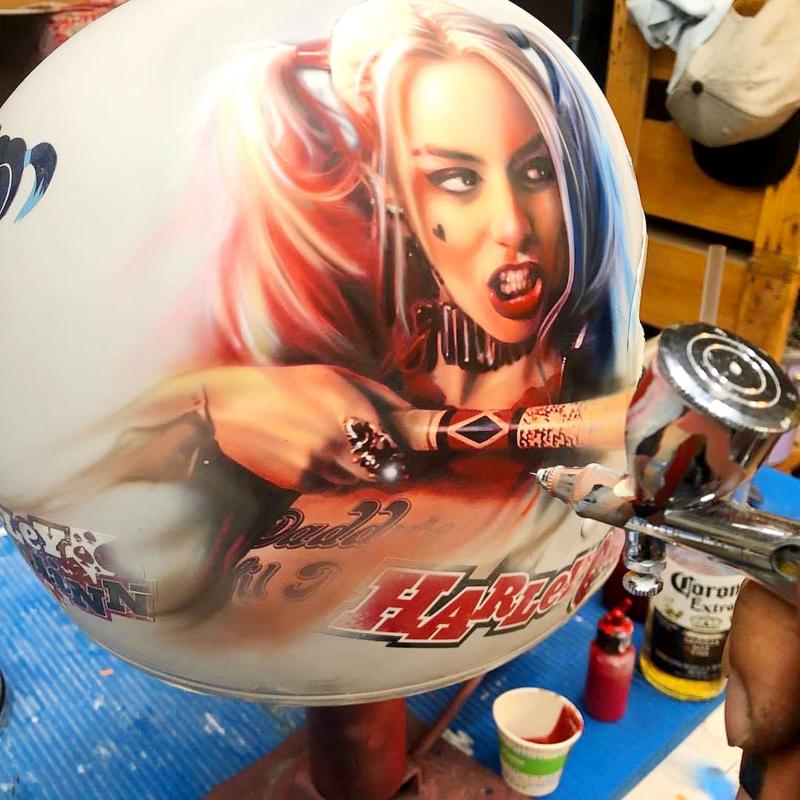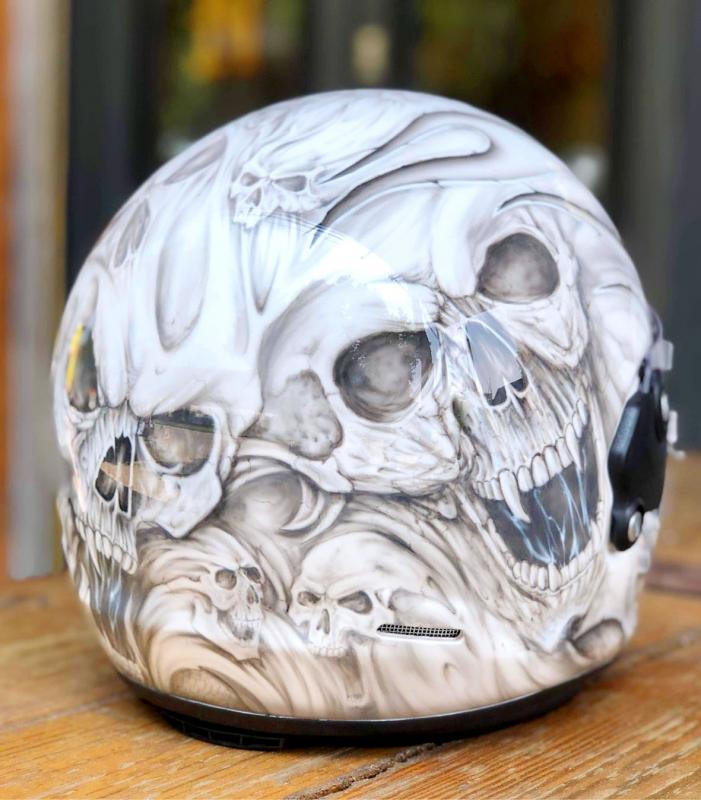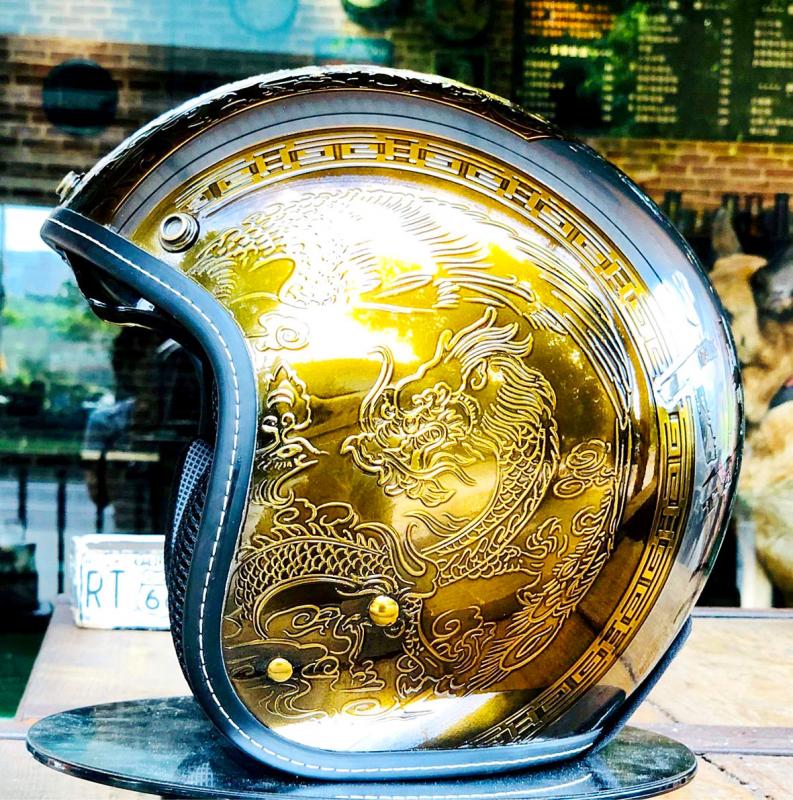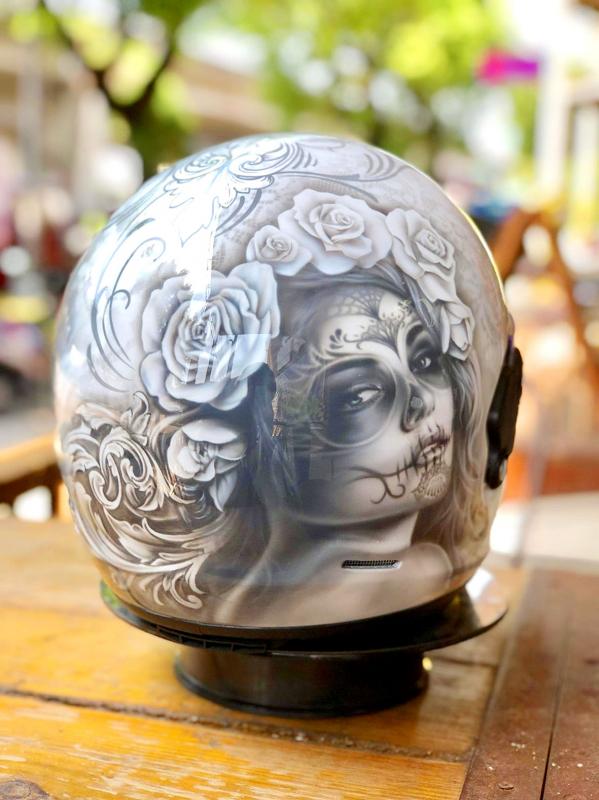When is a scooter helmet not really a helmet? When it’s a piece of art.
Far from the drab and ordinary, Paul Ashworth’s helmet glistens with silver and gold. Snarling serpentine dragons adorn the sides and across the back the word Taiwan is proudly displayed.
“I cherish it,” said Ashworth, 55, an onshore wind farm engineer who has lived in Taichung for two years. “I brought it to work the next day to show everyone.”

Photo courtesy of Lee An of Dupin Custom Painting Studio
Ashworth and others are a different breed of customer in the niche market of custom painted motorcycles and their accompanying helmets. Their purchasing reasons tend to be less practical and more fanciful.
UNIQUE ART
A motorcycle rider back in Norwich, England, Ashworth wanted something unique that showed off his time in Taiwan. He decided it had to have an Asian design and a 3D effect. The rest was up to the artist.

Photo courtesy of Lee An of Dupin Custom Painting Studio
Enter Lee An (安李) of Dupin Custom Painting Studio in Taichung. The 36-year-old artist took Ashworth’s unused Vespa helmet and went to work. After a few weeks of sanding, painting and applying layer upon layer of clear coat lacquer, the embossed helmet was finished. With a cost of NT$13,000, it’s never been worn on the road.
“I’m bringing the helmet back to England to show off in a display case,” Ashworth said.
Inside Lee’s workshop, the atmosphere is as mellow as the artist’s personality. While the music is subdued, the artwork is loud and bold. From smoke and skulls to flowers and dragons, the designs scream to be noticed.

Photo courtesy of Lee An of Dupin Custom Painting Studio
Bringing fantasy to life is a full time job, and at any one time, Lee could be working on up to a dozen helmets. In addition, he also paints motorcycles, mostly Harley-Davidsons, Triumphs and Ducatis.
“Painting is my life,” said Lee, who gave up a job teaching software design at a local university 12 years ago to start his own painting studio. “It’s my passion, not just my business.”
And by most accounts, business has been good. Lee estimates that he has painted a couple thousand helmets and a similar number of motorcycles. Depending on the complexity of the design, the cost of a custom helmet can start at a thousand or so New Taiwan dollars for a simple name or saying, but then run much higher. One of the most expensive helmets Lee painted — a snarling Harley Quinn from the movie Suicide Squad — went for NT$30,000.

Photo courtesy of Lee An of Dupin Custom Painting Studio
While some might balk at the price, others view the helmets as an investment or even as a personalized extension of themselves.
“It’s one way a guy can express himself,” fellow artist Randy Bennett said. “Especially if he wants to stand out.”
TRENDS

Photo courtesy of Lee An of Dupin Custom Painting Studio
While no two customers are alike, there are some trends. Perhaps a soft-spoken person might prefer a gregarious helmet with a fire-breathing dragon. And then there’s the outgoing guy who wants a more subtle look, like ghostly shades of light flickering on a jet black helmet.
“But they all enjoy the attention,” said Bennett, 55, owner of The Black Den custom paint studio in Taichung. “Everyone’s talking to them about their custom designed artwork.”
In his 15 years in the business, Bennett has noticed some other trends. Taiwanese might favor a Japanese anime style, for example, while Westerners opt for an animal, such as a soaring eagle.
Whatever the design and cost, Bennett and Lee take a personal approach to their craft.
Sometimes the hardest part of the project, the artists said, is drawing out of customers what they really want. Whether it starts with browsing through photos on Instagram or sketching out a rough outline, the end goal is to match a client’s desires with the artist’s style to create a satisfying design.
And sometimes that customer rapport turns into a friendship.
“I just told (Lee) the style I wanted,” said Daniel Yang (楊兒承), a 42-year-old restaurateur who says he’s hooked on custom designed paint jobs. “I trust him 100 percent to just get it done.”
It turned out Yang loved the design. For NT$20,000, Lee painted intricate gold trim on the black fuel tank of his Harley Davidson.
After some time, Yang then had a second bike done. Lee painted the Chicano-style Harley, a low-rider with high handlebars, a sparkling emerald green. This time the cost was NT$100,000.
“I get sick of having the same look (as everyone else),” said Yang, who developed his taste for motorcycles while living in Australia. “I simply wanted to show off.”
Ashworth, the British wind farm engineer with the Taiwan-inspired helmet, will soon be another repeat customer. With the Year of the Tiger in mind, he recently asked Lee to paint a small design on his Vespa. And then there’s Ashworth’s wife, who plans to have Lee design a similarly-themed helmet of her own.
Perhaps one day, Ashworth said, the two helmets would both be shown off on the couple’s display case back England.

The unexpected collapse of the recall campaigns is being viewed through many lenses, most of them skewed and self-absorbed. The international media unsurprisingly focuses on what they perceive as the message that Taiwanese voters were sending in the failure of the mass recall, especially to China, the US and to friendly Western nations. This made some sense prior to early last month. One of the main arguments used by recall campaigners for recalling Chinese Nationalist Party (KMT) lawmakers was that they were too pro-China, and by extension not to be trusted with defending the nation. Also by extension, that argument could be

Aug. 4 to Aug. 10 When Coca-Cola finally pushed its way into Taiwan’s market in 1968, it allegedly vowed to wipe out its major domestic rival Hey Song within five years. But Hey Song, which began as a manual operation in a family cow shed in 1925, had proven its resilience, surviving numerous setbacks — including the loss of autonomy and nearly all its assets due to the Japanese colonial government’s wartime economic policy. By the 1960s, Hey Song had risen to the top of Taiwan’s beverage industry. This success was driven not only by president Chang Wen-chi’s

Last week, on the heels of the recall election that turned out so badly for Taiwan, came the news that US President Donald Trump had blocked the transit of President William Lai (賴清德) through the US on his way to Latin America. A few days later the international media reported that in June a scheduled visit by Minister of National Defense Wellington Koo (顧立雄) for high level meetings was canceled by the US after China’s President Xi Jinping (習近平) asked Trump to curb US engagement with Taiwan during a June phone call. The cancellation of Lai’s transit was a gaudy

The centuries-old fiery Chinese spirit baijiu (白酒), long associated with business dinners, is being reshaped to appeal to younger generations as its makers adapt to changing times. Mostly distilled from sorghum, the clear but pungent liquor contains as much as 60 percent alcohol. It’s the usual choice for toasts of gan bei (乾杯), the Chinese expression for bottoms up, and raucous drinking games. “If you like to drink spirits and you’ve never had baijiu, it’s kind of like eating noodles but you’ve never had spaghetti,” said Jim Boyce, a Canadian writer and wine expert who founded World Baijiu Day a decade